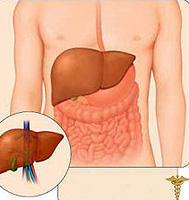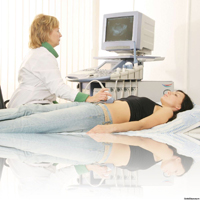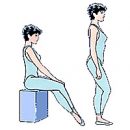The liver is the largest organ of the human body. Her mass reaches 1500 g. - Approximately 1/50 part of the mass of the whole body. Anatomically in the liver is allocated two stakes - right and left. Right share almost 6 times larger than the left. The liver performs the role of filter in the human body.
Content
Jerome Book Hero. Jerome «Three in the boat, not counting the dog» Somehow went to the public London library, took the medical directory, read it, found all sorts of ailments and came out of there a deeply sick person. Among all other diseases, the presence of problems with the liver has been determined by the main symptom - «Disconnection to work». On the one hand, it may seem funny, on the other, the compiler of the reference book, apparently, knew a sense in diagnosis, because, oddly enough, often the only complaint with the diseases of the liver is asthenic syndrome, that is, a decrease in performance, weakness, excessive drowsiness.
Unwillingness to do anything can be the only one, but a characteristic feature. Another thing is that it is nonspecific and occurs when the mass of other diseases. If it is serious about the symptoms that definitely indicate the liver disease, this is jaundice, skin itching, baldness, palm redness, in women - menstrual cycle disorder; Gravity in the abdomen, nausea, belching, unstable stool.
In the later stages there may be an increase in the abdomen because of the accumulation of liquids in it (ascites), darkening of urine (it becomes the color of beer), bleaching feces, subcutaneous bleeding. In order not to bring to such a state, it is necessary at the very first adverse symptoms to deal with. The liver In this sense, the author is grateful - with proper care, it is well restored, and healthy cells can work for themselves and their affected comrades.
What happens during cirrhosis? Healthy liver consists of hepatic lobes. With cirrhosis there is a change in the structure of the liver, the liver contains a large number of connective tissue, and instead of bonds, nodules of different sizes appear, the scarring tissue squeezes blood vessels, the blood circulation is disturbed. The loss of normal hepatic cells leads to the fact that the liver is not able to synthesize proteins and other substances needed by the body, as well as neutralize toxins, that is, perform their functions.
What will help correctly diagnose?
First of all, a visit to a gastroenterologist who, in addition to visual inspection, can take advantage of the following diagnostic methods:
- Biochemical blood test, which will show the increase in hepatic enzymes, increase the number of bilirubin;
- The ultrasound of the liver and other abdominal organs will reveal a change in the size and structure of the liver, the presence of fluid in the abdominal cavity;
- Gastroscopy is useful for assessing the state of the veins of the esophagus and determining the risk of bleeding;
- blood test for virus hepatitis markers;
- In some cases, the liver biopsy is performed (for this, under local anesthesia, a special thin needle pierce the skin directly above the liver, take a piece of fabric);
- The study of liver vessels (angiography, splenoportocavigraphy) with a special contrast agent under the control of the X-ray is necessary when planning surgical treatment.
Throw a drink never late
The most frequent causes of liver cirrhosis - alcohol abuse and viral hepatitis (primarily hepatitis B and C). Less commonly become poisoning toxic substances (for example, a polar refraining poison, some medicines), diseases of the gallbladder and bile ducts, accompanied by a long jaundice.
Growth of environmental pollution, an increase in the use of various preservatives, alcohol, the uncontrolled use of drugs increase the load on the liver.
According to experts, the next 10 years will be marked by the growth of chronic liver pathology associated with the hepatitis virus with.
As for the action of alcohol on the liver, if we talk about «fine» Drinking people and high-quality spirits, the time that must pass from the beginning of use until the development of the liver disease depends on many factors. First, on what quantities a person drinks, secondly, who drinks is a man or a woman. In a woman, with other things being equal, the disease will develop faster and smaller doses. It is believed that for men the maximum allowable dose - 60 g of pure alcohol per day: it's 3 bottles of beer, or 3 glasses of dry wine, or 3 glasses of vodka. What over this, the liver can not recycle without prejudice to itself. In women, liver damage can develop even with a constant reception of 20 g of alcohol a day.
On average, from the beginning of a systematic drunkenness to the emergence of a classic alcoholic cirrhosis takes place at least 8-10 years. In women and adolescents, this period may be shorter - about 5 years. Alcoholic liver damage for a long time can pass asymptomatic. The person drinks and drinks until the liver is no longer able to drive through his blood, occurs stagnation in the portal vein system, increased pressure in it and as a result - ascites - the accumulation of liquid in the abdomen. Often, patients come for the first time to the doctor only at this stage - began to increase the stomach due to the fact that there was a liquid. This is a very important symptom and a serious prognostic sign. Often, if ascites appeared, the life expectancy of the patient is calculated in several years. If a person still does not stop drinking, this gap will be rapidly shrinking. However, if the patient succeeds in convincing the alcohol, despite the fact that he came to doctors already at the stage of ascites, they can observe it 10 or more years without further deterioration. Why? Because he throws to drink, there is no progression of the cirrhotic process, and the restoration of the functions of the liver under these conditions may well occur. Therefore, throwing alcohol is never late.
How to protect the liver?
Drugs in the market quite a lot. Some of them stimulate the development of essential phospholipids - substances necessary to restore the integrity of the hepatic cloth. Others already contain essential phospholipids in the finished form, with natural origin, easily absorbed by the body.
 Even if the process in the liver ends with recovery, the damage still does not pass without a trace and can give a certain functional inferiority, a particular degree of liver dystrophy. In order to avoid this, the doctor may recommend hepatoprotectors - drugs that help the liver restore their structure and protect it from adverse effects. Now at our pharmaceutical market about 30 types of hepatoprotectors: vegetable, homeopathic, synthetic. Most of all preparations of plant origin, including homeopathic. Doctors prefer to prescribe them, because these medicines have a wide range of action, the minimum number of side effects and an acceptable price.
Even if the process in the liver ends with recovery, the damage still does not pass without a trace and can give a certain functional inferiority, a particular degree of liver dystrophy. In order to avoid this, the doctor may recommend hepatoprotectors - drugs that help the liver restore their structure and protect it from adverse effects. Now at our pharmaceutical market about 30 types of hepatoprotectors: vegetable, homeopathic, synthetic. Most of all preparations of plant origin, including homeopathic. Doctors prefer to prescribe them, because these medicines have a wide range of action, the minimum number of side effects and an acceptable price.
As for the liver cirrhosis, the results of its treatment at the same time and disappoint, and encouraged. Violated liver architectonics during liver cirrhosis is no longer restored, but the ability to restore the liver cells is so good that even with cirrhosis can be achieved.
Of course, only a doctor can make the choice of the optimal treatment regimen for a particular patient, but much depends on the patient himself. It is important how he will behave during treatment whether all the recommendations will be able to fulfill both in terms of drug treatment and diet, etc. If you are diagnosed «cirrhosis of the liver» , Carefully follow the advice of the doctor. In addition, care yourself: rest as soon as you feel fatigue. Do not lift gravity: a sharp rise in the pressure in the abdominal cavity can provoke gastrointestinal bleeding. Watch out the frequency of your chair (the optimal frequency of the chair is 2 times a day).
It is necessary to be treated, because the complications of the liver cirrhosis is quite serious. Hepatic encephalopathy - brain damage to toxic products that are not neutralized by the liver as a result of its damage. It can manifest themselves with various disorders of consciousness, intelligence, behavior, neuromuscular disorders. Another possible complication - ascites - the accumulation of fluid in the abdominal cavity. In addition, patients with liver cirrhosis are more susceptible to bacterial and viral infections than healthy people. Most often in such patients there are infections of respiratory tract and urinary system.
What can complain to the patient with cirrhosis
- Increased fatigue.
- Lose weight.
- Various violations of consciousness and behavior (decline in the concentration of attention, drowsiness during the day, violation of night sleep and t. D.).
- Reducing appetite and discomfort in the abdomen (bloating, feeling fast saturation while eating).
- Jaundice (skin coloring, scool in yellow color).
- Loss or discoloration of feces, darkening urine.
- Stomach ache.
- Emirates of the legs and (or) increase in the size of the abdomen due to the free fluid in the abdominal cavity (ascites).
- Bleeding: nasal, gastrointestinal, gums, hemorrhoids, as well as subcutaneous hemorrhages.
- Frequent bacterial infections (respiratory tract, etc.).
- Reduced sexual attraction.
- Men - often gynecomastia (increasing the mammary glands).
It is advisable to exclude the use of mineral waters containing sodium.
Since alcohol contributes to the development of the liver cirrhosis, its use in any species and quantities is prohibited.
With a fluid delay in the body (swelling, ascites), it is necessary to limit the reception of the table salt up to 0.5 g per day, liquids - up to 1000 - 1500 ml per day. Ideally, food must be prepared without adding salt. Consuming baking bread, crackers, cookies and bread, as well as baking oil.
Such seasonings like lemon juice, orange zest, onions, garlic, baking ketchup and mayonnaise, pepper, mustard, sage, cumin, parsley, mayona, laurel sheet, carnation and yeast extract (low salt), help make dishes more pleasant Taste.
Any products containing bakery powder and drinking soda are excluded (cakes, biscuit cookies, cakes, pastries and ordinary bread).
Sickles, olives, ham, bacon, saltin, languages, oysters, mussels, smoked herring, fish and meat canned food, fish and meat pate, sausage, mayonnaise, various bed sauces and all types of cheeses, as well as ice cream.
Salty canned products are excluded.
100 g of beef or poultry meat, rabbit or fish and one egg per day. One egg can replace 50 g meat.
Milk is limited to 1 cup per day. You can eat low-fat sour cream.
You can eat boiled rice (without salt).
Any vegetables and fruits are allowed in a fresh form or in the form of dishes prepared at home.









